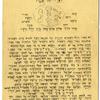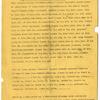4: Images, Passover Haggadah from the Gurs Camp, 1941.
After the French Third Republic surrendered to Nazi Germany in 1940, the Nazi-allied Vichy government began interning Jews who were deported from Belgium and Germany in several detention camps, among them the Gurs camp located in the Pyrenees mountains in southwestern France. There, internees lived, and many died, under conditions of disease and deprivation. In the spring of 1941, a small group of Jews in the camp worked together to produce a Haggadah, the text that sets forth the ritual of the Passover Seder, to celebrate Passover at the camp.
The document, five handwritten pages long, was composed largely from memory by Aryeh Ludwig Zuckerman over many months and under harsh conditions. Rabbi Leo Ansbacher arranged an addendum of Hebrew songs and hymns typed in Latin characters. The Haggadah was used during the 1941 celebration of Passover in the camp. While the Haggadah closely resembles traditional Haggadahs and does not make reference to the circumstances of living in the camp within the body of the text, testimony from survivors attests to its special significance to the camp’s prisoners as an assertion of their own humanity in the face of the dehumanizing conditions they endured. These two images show the first page of the Haggadah and the first page of the Latin-alphabet addendum.
Suggested Activity: In Mash’s “A Seder in the Taiga,” a group of women prisoners in a Soviet gulag improvise to perform the ritual of the Passover Seder under nearly impossible circumstances. The Haggadah from the Gurs Camp represents a similar dedication to the ritual at a moment when mere physical survival seems improbable. Have your students examine the image of the Haggadah and note details that demonstrate the care taken to create this object. Why was it so important to the prisoners in the Gurs camp to have a physical Haggadah, when some prisoners had the text memorized? How might ritual, and ritual objects, be of particular importance in dire circumstances? Ask your students to consider the artifact in relationship to the Seder described in Mash’s story. In what ways do they see the two improvised Seders as emerging from a similar impulse, however your students might understand that impulse (to evoke holiness, to maintain something like normalcy, to connect the present to the past, to imbue the passage of time with meaning)? How do they see these rituals as different?
Also, ask your students to consider: What are the gendered dimensions of these two improvised rituals? What impact might Aryeh Ludwig Zuckerman’s upbringing as a man in a traditional Jewish environment have had on his creation of the document? What are the ways that traditional gender divisions are disrupted or upheld through this artifact and through Mash’s story?
Source: Rabbi Leo Ansbacher and Aryeh Ludwig Zuckerman, Passover Haggadah from the Gurs Camp, 1941, Accession Number 2000.552.1, U.S. Holocaust Memorial Museum, https://perspectives.ushmm.org/item/passover-haggadah-from-the-gurs-camp#. Courtesy of Joan Inge Maas.
614.jpg
 Download image (1.13 MB)
Download image (1.13 MB) 624.jpg
 Download image (1.09 MB)
Download image (1.09 MB)


